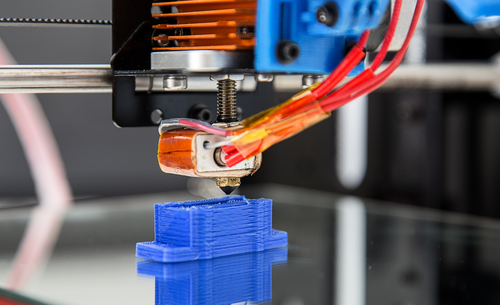IMPORTANT MATERIAL DEVELOPMENTS IN 3D PRINTING
In addition to the many additive manufacturing technologies, 3D printing offers you an even wider range of printable materials. Thus, your specific requirements can often be met in a more efficient way than with a conventional subtractive manufacturing process.
These are the 7 established 3D printing materials on the marketLet's take a closer look at which materials and 3D technologies are currently established in additive manufacturing and for which industries and applications they are particularly suitable.
1. selective laser sintering with polyamide (PA) plastics for robust components
Selective Laser Sintering (also known as SLS printing) can undoubtedly be called by far the most widely used 3D printing process in the industrial sector. SLS printing is based on the selective melting of a source material in powder form by means of a laser beam. Usually the basic materials PA6 and PA12 are used for this purpose, in different (among others refractory) material variants. Typical areas of application are areas where robust components are in demand, such as in the aerospace industry or in toolmaking.
2. FDM printing with ABS for medical technology, dummy construction or architectural models
In Fused Deposition Modeling (FDM) printing, filament (usually ABS) is fed to the printer in roll or stick form. This is melted in its extruder and applied via hot end and nozzle to a printing bed where the model is built up layer by layer. The main areas of application are medical technology, dummy construction or architectural models (click here for the Use Case).
3. MJF process with wax-like materials like VeroClear
The MultiJet-Fusion (MJF) process works in a similar way to FDM printing, namely by melting and then applying the material in layers. Wax-like materials are used, such as VeroClear or different variants of M3. Application areas are especially in the medical field, such as in dentistry.
4. stereolithography with resin for functional parts or prosthesis construction
Stereolithography (also known as SLA printing) is the oldest 3D printing process in existence. A liquid, photopolymer (= light-sensitive) resin is applied layer by layer to a printing plate and cured under UV light.

5th CLIP process with resinThe Continuous Liquid Interface Production (CLIP) process works in principle like stereolithography, only much faster. This is made possible by a special process in which photopolymerisation is controlled in a more targeted manner using UV light and oxygen. Besides resin, the CLIP process also uses polyurethane. The areas of application correspond to those of stereolithography.
6th LCM printing with ceramics for aerospace technologyThe Lithography-based Ceramic Manufacturing (LCM) printing process can be considered a mixture of stereolithography and FDM printing. This 3D technology thus combines the layered construction of a model with the curing of a photopolymer under UV light. This results in models made of high-performance ceramics, which are used in particular in aerospace technology.
7 Selective laser melting with metal for lightweight constructionSelective laser melting (also called SLM printing) works in principle in the same way as selective laser sintering, with the difference that the powder is not sintered. The SLM process is used especially in metal 3D printing. Typical fields of application are lightweight construction, aerospace technology and dentistry.
New 3D printable materials are constantly being developed
Of course, new materials for 3D printing are constantly being developed. As you can see from the list of established printable materials, product development in the area of polymeric materials, i.e. plastic-based materials, is already well advanced and established in the 3D printing market. In the field of metal based materials there are even less printable materials. However, these are currently undergoing particularly strong further development because they offer great potential, particularly for the industrial production of precision lightweight components.
New alloys for metal 3D printingFor example, the German manufacturer EOS launched four new 3D printing metals in May 2019. These were two titanium alloys (EOS Titanium Ti64, Premium, TRL 7, in Grade 5 and 23), as well as one stainless steel alloy (EOS StainlessSteel CX:Premium, TRL 8) and one aluminium alloy (EOS Aluminium AIF357: Premium, TRL7). All these metal alloys are particularly suitable for applications in the automotive industry, as well as in aerospace engineering.
3D printing technologies and materials are constantly evolvingIn an innovative industry like 3D printing, it is not surprising that in addition to the constant optimization of 3D printers, 3D design software is constantly expanding the possibilities of 3D printing itself, new materials are being developed and existing materials are being optimized to make 3D printing attractive for industrial use. We are happy to keep you informed about new developments and 3D printing use cases on the Vibraplast 3D Printing Blog.
Click here to go directly to our 3D service platform!

